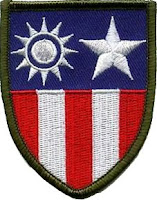Today's item is an important Bharatpur State Gazette issued on 15th May 1945. The gazette carries a message from Maharaja of Bharatpur, Sawai Brijendra Singh on lifting of restrictions imposed as part of National War Front when the war started. Since, the victory is in sight and war is coming to an end, the restrictions are being lifted.
 The Gazette was posted hence carries a seal of 19th May 1945. The message is written in English.
The Gazette was posted hence carries a seal of 19th May 1945. The message is written in English.
As else-where in India, the National War Front was established in this state early in 1942. It was a time when owing to Japan's winning a series of victories almost dramatically and appearing at the eastern gates of our beloved country, nervous minds were badly affected. Foodstuffs and other civil supplies were cornered and even currency coins began to be hoarded. Under such circumstances, I and my Government considered it necessary to restore confidence by mobilising public opinion and forestalling a lowering of morale not only for the sake of Country's War efforts but also for the welfare of my people and a smooth running of their day to day life.
In a public meeting held on the 1st of May 1942, which was attended by my subjects of all caste, creeds and shades of opinion, I explained the aims and objects of the National War Front in the State, and assumed its command as its "Leader". I am glad to note that under the various committees and sectional leaders, my subjects stood to the occasion and were behind nobody in shouldering their responsibilities.
Thanks to the strategy of the Allied Nations, the situation has changed and we are no longer threatened with the dangers which once loomed over our skies. I therefore think that the need for the National War Front has passed, and therefore order that it may be discontinued forthwith. This should however in no case let us slacken our War Efforts which should be furthered with redoubled energy and zeal till final victory is gained over the enemies of liberty and civilization.
We have yet another task before us - effective solution of problems arising directly out of the War, post-war reconstruction and speedy progress of nation building activities. For this purpose my Government has decided to establish a permanent department of Publicity, which is intended to be a more efficient instrument of public information and instruction. It will be essentially mobile in a character and is designed to reach my subjects even in remotest corners of my State. Its approach to the people will be informative and factual rather than emotional or exhoratory and the Staff will be paid and work under the direct supervision and control of my Government.
I cannot close this, without an expression of my deep appreciation of the work done by all officials and non-officials in making the National War Front movement in the State a success.
1-5-45
 The Gazette was posted hence carries a seal of 19th May 1945. The message is written in English.
The Gazette was posted hence carries a seal of 19th May 1945. The message is written in English.PART I.
STATE COUNCIL
Orders, Circulars, Notifications etc.
Notification.
STATE COUNCIL
Orders, Circulars, Notifications etc.
Notification.
As else-where in India, the National War Front was established in this state early in 1942. It was a time when owing to Japan's winning a series of victories almost dramatically and appearing at the eastern gates of our beloved country, nervous minds were badly affected. Foodstuffs and other civil supplies were cornered and even currency coins began to be hoarded. Under such circumstances, I and my Government considered it necessary to restore confidence by mobilising public opinion and forestalling a lowering of morale not only for the sake of Country's War efforts but also for the welfare of my people and a smooth running of their day to day life.
In a public meeting held on the 1st of May 1942, which was attended by my subjects of all caste, creeds and shades of opinion, I explained the aims and objects of the National War Front in the State, and assumed its command as its "Leader". I am glad to note that under the various committees and sectional leaders, my subjects stood to the occasion and were behind nobody in shouldering their responsibilities.
Thanks to the strategy of the Allied Nations, the situation has changed and we are no longer threatened with the dangers which once loomed over our skies. I therefore think that the need for the National War Front has passed, and therefore order that it may be discontinued forthwith. This should however in no case let us slacken our War Efforts which should be furthered with redoubled energy and zeal till final victory is gained over the enemies of liberty and civilization.
We have yet another task before us - effective solution of problems arising directly out of the War, post-war reconstruction and speedy progress of nation building activities. For this purpose my Government has decided to establish a permanent department of Publicity, which is intended to be a more efficient instrument of public information and instruction. It will be essentially mobile in a character and is designed to reach my subjects even in remotest corners of my State. Its approach to the people will be informative and factual rather than emotional or exhoratory and the Staff will be paid and work under the direct supervision and control of my Government.
I cannot close this, without an expression of my deep appreciation of the work done by all officials and non-officials in making the National War Front movement in the State a success.
1-5-45
SAWAI BRIJENDRA SINGH,
Maharaja of Bharatpur.
Maharaja of Bharatpur.

























